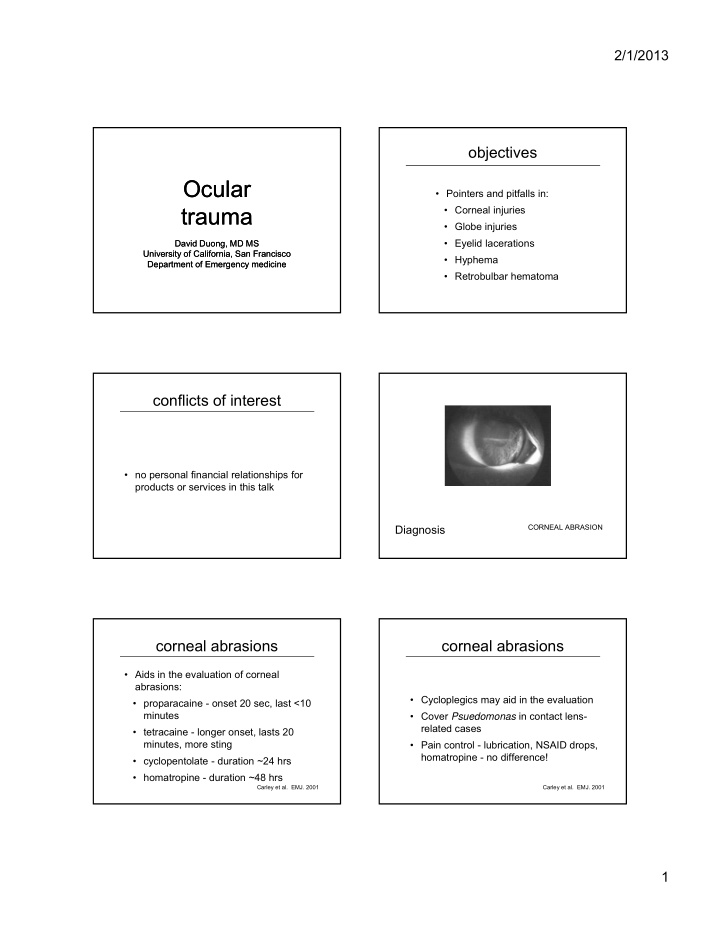



2/1/2013 objectives Ocular Ocular • Pointers and pitfalls in: trauma trauma • Corneal injuries • Globe injuries • Eyelid lacerations David Duong, MD MS David Duong, MD MS University of California, San Francisco University of California, San Francisco • Hyphema Department of Emergency medicine Department of Emergency medicine • Retrobulbar hematoma conflicts of interest • no personal financial relationships for products or services in this talk Diagnosis CORNEAL ABRASION corneal abrasions corneal abrasions • Aids in the evaluation of corneal abrasions: • Cycloplegics may aid in the evaluation • proparacaine - onset 20 sec, last <10 minutes • Cover Psuedomonas in contact lens- related cases • tetracaine - longer onset, lasts 20 minutes, more sting • Pain control - lubrication, NSAID drops, homatropine - no difference! • cyclopentolate - duration ~24 hrs • homatropine - duration ~48 hrs Carley et al. EMJ. 2001 Carley et al. EMJ. 2001 1
2/1/2013 corneal abrasions pitfalls • Not ruling out a corneal ulcer • Not everting the lid • Not consider corneal laceration • Not using a wood ’ s lamp, if slit lamp is not possible video - woods lamp video - woods lamp Pediatric tips • Consider anesthetic drops and cycloplegia for evaluation • Ointment antibiotics - longer lubricating effects and much less sting • 1 drop of cycloplegia before discharge • Persistent pain >1 day in kids is a red flag Diagnosis CORNEAL FOREIGN BODY foreign body removal foreign body removal video video 2
2/1/2013 subtarsal foreign body subtarsal foreign body video - everting the lid video - everting the lid anatomy anatomy high risk lacerations? ALL OF THEM eyelid lacerations • Ophthalmology or Plastics service should repair lacerations involving: • tarsal plate • eyelid margin • nasolacrimal system canalicular laceration canalicular laceration 3
2/1/2013 eyelid laceration pitfalls globe rupture • Decreased Va • RAPD • Eccentric pupil • Not assuming there are other ocular injuries • Bullous subconjunctival hemorrhage • Not obtaining visual acuity • Extrusion of vitreous • Hyphema • Seidel test seidel test video seidel test video video - benzoin to video - benzoin to exam the eye exam the eye 4
2/1/2013 key actions globe rupture • Consult ophthalmology • Protect the eye (eye shield, avoid eye manipulation) • Antibiotic prophylaxis • Avoid ocular extrusion (antiemetics, pain meds, sedation) retracting the eyelid retracting the eyelid • Tetanus prophylaxis video video HYPHEMA TREATMENT HYPHEMA TREATMENT good prognosis microhyphema eye shield HOB >30 deg cycloplegia <33% (Grade 1) ophtho referral no NSAIDS Diagnosis HYPHEMA 33-50% (Grade 2) microhyphema, grade 1-2 HYPHEMA TREATMENT HYPHEMA TREATMENT hyphema ophtho consult >50% (Grade 3 & 4) eye shield HOB >30 deg • usually resolve in a week ↑ IOP (>24) no NSAIDS • 90% maintain a Va of 20/50 or better topical B-blocker for • refer to ophthalmology within 5 days increased IOP sickle cell 5
2/1/2013 HYPHEMA PITFALLS • Not considering globe rupture or IOFB • Discharging with NSAIDs • Neglecting close ophthalmology follow- up Retrobulbar hematoma Lateral Canthotomy Lateral Canthotomy • Caused by blood accumulation within the orbit with transmission of pressure to the optic nerve and globe. This in turn leads to central retinal artery occlusion and optic nerve ischemia • Signs - acute proptosis, vision loss, decrease in ocular movement, increased IOP • Irreversible vision loss occurs within 60 minutes • DEFINITIVE treatment option is a lateral canthotomy particular thanks to those particular thanks to those Thank you for your Thank you for your who gave consent to be who gave consent to be attention! attention! photographed for photographed for educational purposes educational purposes david.duong@emergency.ucsf.edu david.duong@emergency.ucsf.edu 6
Recommend
More recommend